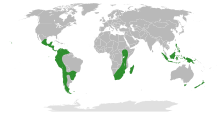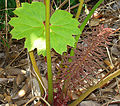Gunnera
| Gunnera Temporal range: Late Cretaceous - present,
| |
|---|---|

| |
| Gunnera tinctoria at the San Francisco Botanical Garden at Strybing Arboretum | |
| Scientific classification | |
| Kingdom: | Plantae |
| Clade: | Tracheophytes |
| Clade: | Angiosperms |
| Clade: | Eudicots |
| Order: | Gunnerales |
| Family: | Gunneraceae Meisn.[1] |
| Genus: | Gunnera L. |

| |
| The range of the genus Gunnera[2] | |
| Synonyms[3] | |
| |


Gunnera is the sole genus of
Taxonomy
Gunnera is the only genus in the family Gunneraceae.
The genus Gunnera was named after the Norwegian botanist
Evolution
Gunnera is thought to be a rather ancient group, with a well-documented fossil history due to the presence of fossilized
Due to the widespread distribution of Gunnera during the Cretaceous, it was previously thought that the modern disjunct distribution of the genus was a relic of this period. However, phylogenetic analysis indicates that the majority of Gunnera species, even those found on entirely different continents, diverged from each other during the
Description
The 40–50 species vary enormously in leaf size, with the iconic large-leaved species belonging to the subgenus Panke. The giant rhubarb, or Campos des Loges (Gunnera manicata), native to the Serra do Mar mountains of southeastern Brazil, is perhaps the largest species, with reniform or sub-reniform leaves typically 1.5 to 2.0 meters (4 ft 11 in to 6 ft 7 in) long, not including the thick, succulent petiole which may be up to 2.5 meters (8 feet 2 inches) in length. The width of the leaf blade is typically 2.5 meters (8 feet 2 inches), but on two occasions cultivated specimens (in Dorset, England in 2011[12] and at Narrowwater, Ulster, Ireland[13] in 1903) produced leaves fully 3.3 meters (10 feet 10 inches) in width. The seeds germinate best in very moist, but not wet, conditions and temperatures of 22–29 °C.
Only slightly smaller is G. masafuerae of the
Outside of the subgenus Panke, most of the more basal Gunnera species have small-to-medium-sized leaves. There are some species with moderately large leaves in Africa (G. perpensa, in the subgenus Perpensum) and Southeast Asia (G. macrophylla, in the subgenus Pseudogunnera), but the majority of more basal species are low-lying, mat-forming plants with small leaves. There are several small species are found in New Zealand, notably G. albocarpa, with leaves only 1–2 cm long, and also in South America, with G. magellanica having leaves 5–9 cm wide on stalks 8–15 cm long. The most basal species in the genus, G. herteri of Brazil, also has small leaves.[17][18]
Some fossil leaf impressions of Gunnera from the Cretaceous of North America have large leaves akin to those of Panke, and the most basal extant species within Panke (G. mexicana) is the most northern member. For this reason, it has been suggested that Panke originates from South American Gunnera that colonized North America during the Cretaceous and grew into giant forms, with the remaining South American Gunnera evolving into the subgenus Misandra, with a low-lying, matlike growth. During the Cenozoic, the North American Panke would have colonized Hawaii and retreated southwards on the mainland before recolonizing South America. However, more recent phylogenetic evidence suggests that Misandra and Panke diverged only 15 million years ago, much too recent to assign the Cretaceous Gunnera to Panke. Due to this, the large-leaved Cretaceous Gunnera from North America may represent a distinct lineage that convergently evolved giant leaves similar to those of Panke, but did not leave any descendants. [10][17][19]
Species
As of April 2023[update], Plants of the World Online accepts the following species[20] separated by subgenus:[21]
| Subgenus | Image | Scientific name | Distribution |
|---|---|---|---|
| Ostenigunnera Mattfeld, 1933 | Gunnera herteri Osten | Uruguay, S Brazil | |
| Pseudogunnera Schindler, 1905 |  |
Gunnera macrophylla Blume | Papuasia, Indonesia, Philippines |
| Milligania Schindler, 1905 | Gunnera albocarpa (Kirk) Cockayne | New Zealand | |
| Gunnera arenaria Cheeseman ex Kirk | New Zealand | ||
| Gunnera cordifolia (Hook.f.) Hook.f. | Tasmania | ||
| Gunnera densiflora Hook.f. | New Zealand | ||
 |
Gunnera dentata Kirk | New Zealand | |
| Gunnera flavida Colenso | New Zealand | ||
 |
Gunnera hamiltonii Kirk ex W.S.Ham. | New Zealand | |
| Gunnera mixta Kirk | New Zealand | ||
 |
Gunnera monoica Raoul | New Zealand incl Chatham Islands | |
 |
Gunnera prorepens Hook.f. | New Zealand | |
| Gunnera reniformis Ridl. | New Guinea | ||
| Gunnera strigosa (Kirk) Colenso | New Zealand | ||
| Panke Schindler, 1905 | Gunnera aequatoriensis L.E.Mora | Ecuador | |
| Gunnera annae Schindl. | Peru, Bolivia | ||
| Gunnera antioquensis L.E.Mora | Colombia | ||
| Gunnera apiculata Schindl. | Bolivia, Argentina | ||
| Gunnera atropurpurea L.E.Mora | Colombia, Ecuador | ||
| Gunnera berteroi Phil. | Bolivia, Argentina, Chile | ||
| Gunnera bogotana L.E.Mora | Colombia | ||
| Gunnera bolivari J.F.Macbr. | Peru, Ecuador | ||
| Gunnera boliviana Morong | Bolivia | ||
| Gunnera bracteata Steud. ex Benn. | Robinson Crusoe Island in Chile | ||
 |
Gunnera brephogea Linden & André | Colombia, Ecuador, Peru | |
| Gunnera caucana L.E.Mora | Colombia | ||
| Gunnera colombiana L.E.Mora | Colombia, Ecuador | ||
| Gunnera × cryptica J.M.H.Shaw (G. manicata × G. tinctoria) | Cultivated | ||
| Gunnera cuatrecasasii L.E.Mora | Colombia | ||
| Gunnera diazii L.E.Mora | Colombia | ||
| Gunnera garciae-barrigae L.E.Mora | Colombia | ||
| Gunnera hernandezii L.E.Mora | Colombia | ||
 |
Gunnera insignis (Oerst.) Oerst. | Panama, Nicaragua, Costa Rica | |
| Gunnera × katherine-wilsoniae L.D.Gómez (G. insignis × G. talamancana) | Costa Rica | ||
| Gunnera kauaiensis Rock | Kauai in Hawaii | ||
 |
Gunnera killipiana Lundell | Chiapas, Guatemala, Honduras | |
| Gunnera lozanoi L.E.Mora | Colombia | ||
| Gunnera magnifica H.St.John | Colombia | ||
 |
Gunnera manicata Linden ex André | S Brazil | |
| Gunnera margaretae Schindl. | Peru, Bolivia | ||
| Gunnera masafuerae Skottsb. | Alejandro Selkirk Island (Isla Mas Afuera) in Chile | ||
 |
Gunnera mexicana Brandegee | Veracruz, Chiapas | |
| Gunnera morae Wanntorp & Klack. | Colombia | ||
| Gunnera peltata Phil. | Robinson Crusoe Island in Chile | ||
| Gunnera peruviana J.F.Macbr. | Ecuador, Peru | ||
 |
Gunnera petaloidea Gaudich. | Hawaii | |
| Gunnera pilosa Kunth | Peru, Bolivia, Ecuador | ||
| Gunnera pittieriana V.M.Badillo & Steyerm. | Venezuela | ||
| Gunnera quitoensis L.E.Mora | Ecuador | ||
| Gunnera saint-johnii (L.E.Mora) L.E.Mora | Colombia | ||
| Gunnera sanctae-marthae L.E.Mora | Colombia | ||
| Gunnera schindleri L.E.Mora | Bolivia, Argentina | ||
 |
Gunnera schultesii L.E.Mora | Colombia | |
| Gunnera silvioana L.E.Mora | Ecuador, Colombia | ||
| Gunnera steyermarkii L.E.Mora | Venezuela | ||
| Gunnera tacueyana L.E.Mora | Colombia | ||
| Gunnera tajumbina L.E.Mora | Ecuador, Colombia | ||
 |
Gunnera talamancana H.Weber & L.E.Mora | Costa Rica, Panama | |
| Gunnera tamanensis L.E.Mora | Colombia | ||
 |
Gunnera tayrona L.E.Mora | Colombia | |
 |
Gunnera tinctoria (Molina) Mirb. | Chile, Argentina | |
| Gunnera venezolana L.E.Mora | Venezuela | ||
| Misandra Schindler, 1905 |  |
Gunnera magellanica Lam. | W + S South America, Falkland Is. |
| Gunnera lobata Hook.f. | Tierra del Fuego | ||
| Gunnera |  |
Gunnera perpensa L. | Africa, Madagascar |
In 2022, it was shown that plants in cultivation under the name Gunnera manicata were actually a hybrid, Gunnera × cryptica.[22]
Cyanobacterial symbiosis
At least some species of Gunnera host endosymbiotic cyanobacteria such as Nostoc punctiforme. The cyanobacteria provide fixed nitrogen to the plant, while the plant provides fixed carbon to the microbe.[23] The bacteria enter the plant via glands found at the base of each leaf stalk[2] and initiate an intracellular symbiosis which is thought to provide the plant with fixed nitrogen in return for fixed carbon for the bacterium. The Nostoc filled symbiotic tissue makes up just a small portion of the plant's total biomass. Gunnera is the only known genus of angiosperms that hosts cyanobacteria, and the only known landplants with intracellular cyanobionts. Although the endosymbionts enters the cell wall, they do not penetrate the cell membrane.[24][25] This relationship may provide insights to allow the creation of novel symbioses between crop plants and cyanobacteria, allowing growth in areas lacking fixed nitrogen in the soil.
Uses
The stalks of G. tinctoria (nalca), from southern Chile and Argentina, are edible.[4] Their principal use is fresh consumption, after peeling, but also they are prepared in salads, liquor or marmalade. Leaves of this species are used in covering curanto (a traditional Chilean food).
Gunnera perpensa is a source of traditional medicine in southern Africa, both in veterinary and human ailments, largely in obstetric and digestive complaints, but also as a wound dressing.[7] It also is eaten in various ways, largely the petioles, flower stalks and leaves, fresh and raw, preferably with skins and fibre removed, which is said to remove bitterness, but also cooked. The plant also is said to be used in making a beer.[26]
References
- hdl:10654/18083.
- ^ PMID 33874210.
- ^ a b Kew World Checklist of Selected Plant Families
- ^ a b "Nalca". TasteAtlas. Retrieved 6 May 2023.
- .
- ISSN 0024-4074.
- ^ a b Watt JM, Breyer-Brandwijk MG, Gerdina M (1962). "Halorrhagidaceae". The Medicinal and Poisonous Plants of Southern and Eastern Africa (Second ed.). E & S Livingstone. p. 500.
- S2CID 42201778.
- JSTOR 2387727.
- ^ PMID 29576938.
- S2CID 83060879.
- ^ "Abbotsbury Gardens celebrates plant's 'monster' leaves". BBC. 14 October 2011.
- ^ "Unknown". The Garden. 63 (1631). London: 125. 21 February 1903.
- ^ Skottsberg C (1953). "The Phanerogams of Juan Fernandez Islands". The Natural History of Juan Fernandez and Ester Islands. Vol. 2. Uppsala: Almquist & Wiksells Boktryckeri AB. p. 151.
- ^ St John H (January 1959). "Gunnera the Magnificent - Giant Herb of Colombia". Chicago Natural History Museum Bulletin. 30 (1): 3 plus photo on front cover.
- ^ "Gunneraceae Gunnera". Plants for Use. Retrieved January 20, 2009.
- ^ ISSN 0024-4074.
- S2CID 24561923.
- S2CID 83697864.
- ^ "Gunnera L. - Plants of the World Online". Plants of the World Online. 2020-06-22. Retrieved 2023-04-25.
- ISSN 1095-8339.
- S2CID 252243597.
- PMID 11782524.
- ISBN 9780323993357.
- PMID 16113217.
- ISBN 978-0908387328.
External links
 Media related to Gunnera at Wikimedia Commons
Media related to Gunnera at Wikimedia Commons Data related to Gunnera at Wikispecies
Data related to Gunnera at Wikispecies- Gunneraceae Archived 2006-01-04 at the Wayback Machine in L. Watson and M.J. Dallwitz (1992 onwards). The families of flowering plants Archived 2007-01-03 at the Wayback Machine: descriptions, illustrations, identification, information retrieval. Version: 21 May 2006. http://delta-intkey.com Archived 2007-01-03 at the Wayback Machine
- links at CSDL
- Gunnera magellanica pictures from Chilebosque
- Global Invasive Species database tinctoria
- Medicinal plant details Gunnera perpensa
- "Gunnera on Achill Island". Achill Journal. Archived from the original on 2007-09-29.
